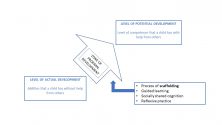“The principle goal of education in the schools should be creating men and woman who are capable of doing new things, not simply repeating what other generations have done.” – Jean Piaget
Within a sociocultural and constructivist framework, Vygotsky coined the term “Zone of Proximal Development” to explain the relationship between development and learning referencing “the distance between the actual developmental level as determined by independent problem solving and the level of potential development as determined through problem solving under adult guidance.” (Vygotsky).

The pattern of learning and development is an ongoing process. Children are constantly facing problems that must be solved but sometimes, because of their maturity level, they are unable to find the solution on their own. That is why Bruner incorporated the concept of “scaffolding” into the framework of this theory, as a way of describing the help and support provided by adults. This help could be given as reminders, key pieces of information, help with small details, encouragement, etc. Facilitates a transfer of learning that helps to raise children with more independent, logical, and practical minds.
To take advantage of Problem Based Learning it is important to take into account
- The information should be clear and adjusted to their ability providing them with the tools needed to solve the problem later.
- Learning should be challenging but not impossible, encouraging and motivating them to find a solution.
- Reflexive practice must predominate guiding the younger generation to finding their own solutions, but never giving them the answers ourselves, they must be the ones to find them. There is no better learning than experience.
- Mistakes are part of the process. Teaching a little one this lesson is a crucial part of their development. Always encourage them to repeat and try again, even when they make a mistake.
- Intervention should be inversely proportional, in other words, the more the child is able to solve the problem, the less help we will give. At first, we should help and then, progressively, help less and less as they begin to acquire the necessary skills.
”To touch a child is to touch the most delicate and vital point, where everything can be decided and renewed, where everything is full of life, where the secrets of the soul are locked, that is how the education of the man of tomorrow is elaborated.” – María Montessori
Learn More:
- Examples of 3rd Grade Math Word Problems with Solutions
- 7 Advantages of Children That Know How to Solve Problems
- Stimulation of Mathematical Talent with Smartick
- Examples of Second Grade Word Problems with Solutions
- Self-Explanation in the Learning Process







